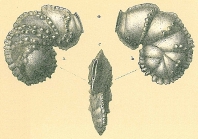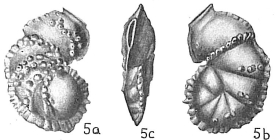WoRMS taxon details
Siphoninella Cushman, 1927
416302 (urn:lsid:marinespecies.org:taxname:416302)
accepted
Genus
Truncatulina soluta (Brady, 1881) accepted as Siphoninella soluta (Brady, 1881) (type by monotypy)
marine, brackish, fresh, terrestrial
Cushman, J. A. (1927). An outline of a re-classification of the Foraminifera. <em>Contributions from the Cushman Laboratory for Foraminiferal Research.</em> 3(1): 1-105., available online at https://cushmanfoundation.allenpress.com/Portals/_default/files/pubarchive/cclfr/3cclfr1.pdf
page(s): p. 77 [details] Available for editors [request]
[request]
page(s): p. 77 [details] Available for editors
Hayward, B.W.; Le Coze, F.; Vachard, D.; Gross, O. (2025). World Foraminifera Database. Siphoninella Cushman, 1927. Accessed through: World Register of Marine Species at: https://www.marinespecies.org/aphia.php?p=taxdetails&id=416302 on 2025-04-04
Date
action
by
2009-09-25 05:45:02Z
created
db_admin
![]() The webpage text is licensed under a Creative Commons
Attribution 4.0 License
The webpage text is licensed under a Creative Commons
Attribution 4.0 License
Nomenclature
original description
Cushman, J. A. (1927). An outline of a re-classification of the Foraminifera. <em>Contributions from the Cushman Laboratory for Foraminiferal Research.</em> 3(1): 1-105., available online at https://cushmanfoundation.allenpress.com/Portals/_default/files/pubarchive/cclfr/3cclfr1.pdf
page(s): p. 77 [details] Available for editors [request]
[request]
page(s): p. 77 [details] Available for editors
Other
additional source
Loeblich, A. R.; Tappan, H. (1987). Foraminiferal Genera and their Classification. Van Nostrand Reinhold Company, New York. 970pp., available online at https://books.google.pt/books?id=n_BqCQAAQBAJ [details] Available for editors  [request]
[request]
From editor or global species database
Diagnosis Test with early stage lenticular and chambers trochospirally coiled, later stage uncoiling, uniserial, and rectilinear, sutures curved, limbate, and beaded on the spiral side, nearly radial and slightly depressed on the umbilical side, umbilicus closed, sutures of rectilinear stage may be beaded on both sides, periphery with fimbriate carina; wall calcareous, perforate, surface smooth other than the fimbriate to beaded keel and sutures; aperture terminal, an elongate narrow slit produced on a distinct neck, with phialine lip. M. Eocene to Holocene; Caribbean; North America. (Loeblich & Tappan, 1987, Foraminiferal Genera and Their Classification) [details]


